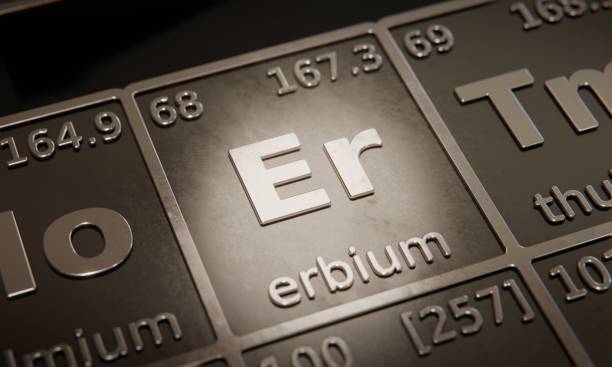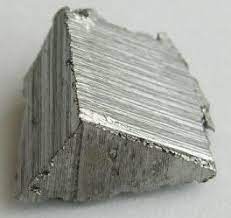Identity.
Erbium, with its symbol Er and atomic number 68, isn't your average
metal. This rare-earth element, though elusive in its pure form, hides
within minerals like monazite. Despite its silvery-white appearance,
erbium's true identity lies in its unique properties. It boasts a
surprising resistance to tarnishing, and its compounds paint the world
in delicate shades of pink, used in everything from ceramics to
simulated gems. But its most impactful identity lies in its ability to
amplify light, propelling signals through fiber optic cables and
powering next-generation technology.
Atomic Structure:
The nucleus consists of 68 protons (red) and 99 neutrons (orange). 68
electrons (white) successively occupy available electron shells
(rings). Erbium is a lanthanide in period 6, and the f-block of the
periodic table. It melts at 1529 degrees Celsius.
History.
The story of erbium begins in 1843, amidst the scientific buzz
surrounding "rare earths." Swedish chemist Carl Gustaf Mosander was
diligently dissecting a mineral called gadolinite, hoping to uncover
its secrets. His efforts yielded not one, but two new elements: a
rose-colored compound he named terbium, and a deep-yellow peroxide
christened erbium. However, the early days were clouded by confusion.
The similar properties of these newfound elements led to an identity
swap, with erbium's name mistakenly attached to another element for
decades.
Erbium's true nature gradually came to light. By the late 19th
century, scientists like Jean-Charles Galissard de Marignac were
able to separate it from its impostor, revealing its true pinkish
hues and unique magnetic properties. The 20th century saw erbium
blossom. Its light-amplifying powers earned it a pivotal role in
fiber optic technology, revolutionizing communication. Meanwhile,
researchers delved deeper, exploring its potential in lasers,
medical imaging, and even its possible influence on human
metabolism.
Today, erbium's journey continues. From its initial
misidentification to its vital role in modern technology, the
element's story reminds us of the constant evolution of scientific
understanding. As research unfolds, erbium's potential seems
limitless, promising exciting discoveries and further shaping the
world around us.
Usage.
Erbium, the pink-tinted hero of our interconnected world, amplifies
light signals in fiber optic cables, ensuring your internet speed
stays blazing fast. Beyond its digital magic, it adds a rosy touch to
ceramics and glasses, and scientists are exploring its potential in
lasers, medical imaging, and even the mysteries of life, making erbium
a truly diverse and fascinating element.
-
Amplifying the Information Age: Erbium is the hidden hero
of your internet speed. Doped into fiber optic cables, it acts as
a signal booster, amplifying light pulses and enabling data to
travel long distances without losing strength. This makes it vital
for powering today's interconnected world.
-
Coloring Our WorldEver admired the delicate pink hues in
certain ceramics or imitation gems? Erbium oxide is often the
culprit! Its compounds add a distinctive pinkish tinge, used in
glazes, glasses, and even some sunglasses. So, next time you see a
touch of rose, you might be witnessing the subtle influence of
erbium.
-
Pusing the Boundaroes of Technology: The potential of
erbium extends beyond everyday applications. Researchers are
exploring its use in cutting-edge technologies like lasers, where
its specific properties could pave the way for more efficient and
powerful devices. Additionally, its unique interactions with light
might hold promise for advancements in medical imaging, offering
clearer diagnostics and treatment options.
Some of the benefits of using Erbium are:
-
Erbium is the silent champion of your internet speeds. Embedded in
fiber optic cables, it amplifies light signals, allowing data to
travel long distances efficiently. This translates to faster
downloads, smoother streaming, and a more connected world.
-
Erbium lasers are carving a niche in the medical field. Their
unique properties enable precise incisions with minimal tissue
damage, making them ideal for delicate procedures like eye surgery
and skin resurfacing. Additionally, its light interaction
properties hold promise for improved medical imaging, potentially
leading to earlier disease detection and better treatment
outcomes.
-
Erbium's ability to interact with specific materials can be
harnessed for non-destructive testing. In industries like
aerospace and energy, erbium-based techniques help inspect cracks
and flaws in materials, ensuring safety and preventing potential
disasters.
-
As we move towards a greener future, erbium presents itself as a
sustainable alternative in some applications. Its efficiency in
specific lasers reduces energy consumption compared to traditional
counterparts, contributing to a more environmentally conscious
approach in technology.
Sources.
While not found pure in nature, erbium hides within minerals like
monazite and xenotime, often alongside its fellow rare-earth elements.
China currently dominates erbium production, mainly extracting it from
ion adsorption clays found in its southern regions. Though
historically recovered from monazite and bastnasite ores, these
sources typically contain erbium only in small quantities. With rising
demand and potential future shortages, researchers are exploring
alternative sources like deep-sea mud and even recycling electronics
for the pink treasure.
Properties.
Light Amplification: Erbium possesses unique electronic
properties that allow it to absorb and re-emit light at specific
wavelengths. This makes it a vital component in fiber optic
amplifiers, boosting the signal strength of light pulses traveling
through communication cables, powering our fast internet connections.
Distinct Pink Hue: Although erbium appears silvery-white in its
pure form, its compounds exhibit a characteristic pinkish color. This
property makes erbium oxide a popular additive in ceramics and
glasses, used to create delicate pink shades and even simulate
gemstones.
Magnetic QuriksUnlike many metals, erbium exhibits
antiferromagnetic behavior at low temperatures. This means its atomic
spins align in an alternating pattern, cancelling out their overall
magnetic moment. This particular magnetic behavior has interesting
applications in research areas like spintronics and magnetic
refrigeration.

